There are plenty of good reasons you should be completing your weekly quota of 10 Best Chest Workout Exercises for Building Muscle. Your chest is composed of some of the most used muscles in your body. This means that even when you aren’t in the gym, you are using them all the time. Picking up boxes? Pushing open a heavy door? Waving at a friend? The answer is yes to all of these, so it’s probably a good idea to develop them into something we’re proud of. Whether you’re lifting with dreams of pure aesthetics or the goal of incredible performance, you’re going to need to workout properly to get good results, So here we will see the 10 Best Chest Workout Exercises for Building Muscle.
We’re here to give you all the details about the 10 Best Chest Workout Exercises for Building Muscle you can do. Most men have aspired to have those powerful pectorals that really fill out a workout shirt. No guy wants to stand in front of the mirror and see man boobs, or “moobs” for short. With these 10 Best Chest Workout Exercises for Building Muscle at your disposal, you too can have larger-than-life chest muscles that are tougher than a board. With a good routine and strict regimen, results will come in no time at all. As they say, slow and steady truly does win the race and you should take these words to heart. Overdoing these workouts will most likely hamper your progress rather than help it, so remember to do everything in moderation.

The sheer volume of chest exercises out there can make it difficult to know what exactly to do, or even if you’re doing those things properly. There are dozens upon dozens of different chest workouts and variations that you can do on chest day, but you probably don’t want to spend all Monday afternoon, or multiple Mondays, trying all of them out. Ideally, you should be sticking to a couple of the 10 Best Chest Workout Exercises for Building Muscle and continually trying to improve on those week after week. With the amount of exercises, there are out there, we’ve done the work and narrowed the list to some of the 10 Best Chest Workout Exercises for Building Muscle workouts for you to try.
Now these aren’t necessarily a list of the hardest or most challenging workouts. It is focused on what we believe to be, pound-for-pound, the best and most efficient mass builders. We’ve also provided an explanation and a quick “how to” to help you get started. These are great to swap in for exercises in your current routine, build a whole new chest regimen with them, or just to change things up and keep things fresh when you get bored of your standard routine. But first, let us touch on some things you should know before jumping straight into it. If you’re already a workout vet and here just for the exercises, feel free to scroll down to get to the 10 Best Chest Workout Exercises for Building Muscle.
According to the Physical Activity Guidelines for AmericansTrusted Source, people should perform muscle-strengthening activities on at least 2 days of the week. One set of 8 to 12 repetitions (reps) is effective in resistance training, but 2 or 3 sets may be more effective.
This article describes exercises that help people gain strength and definition in the lower chest.
Dumbbell Pullover
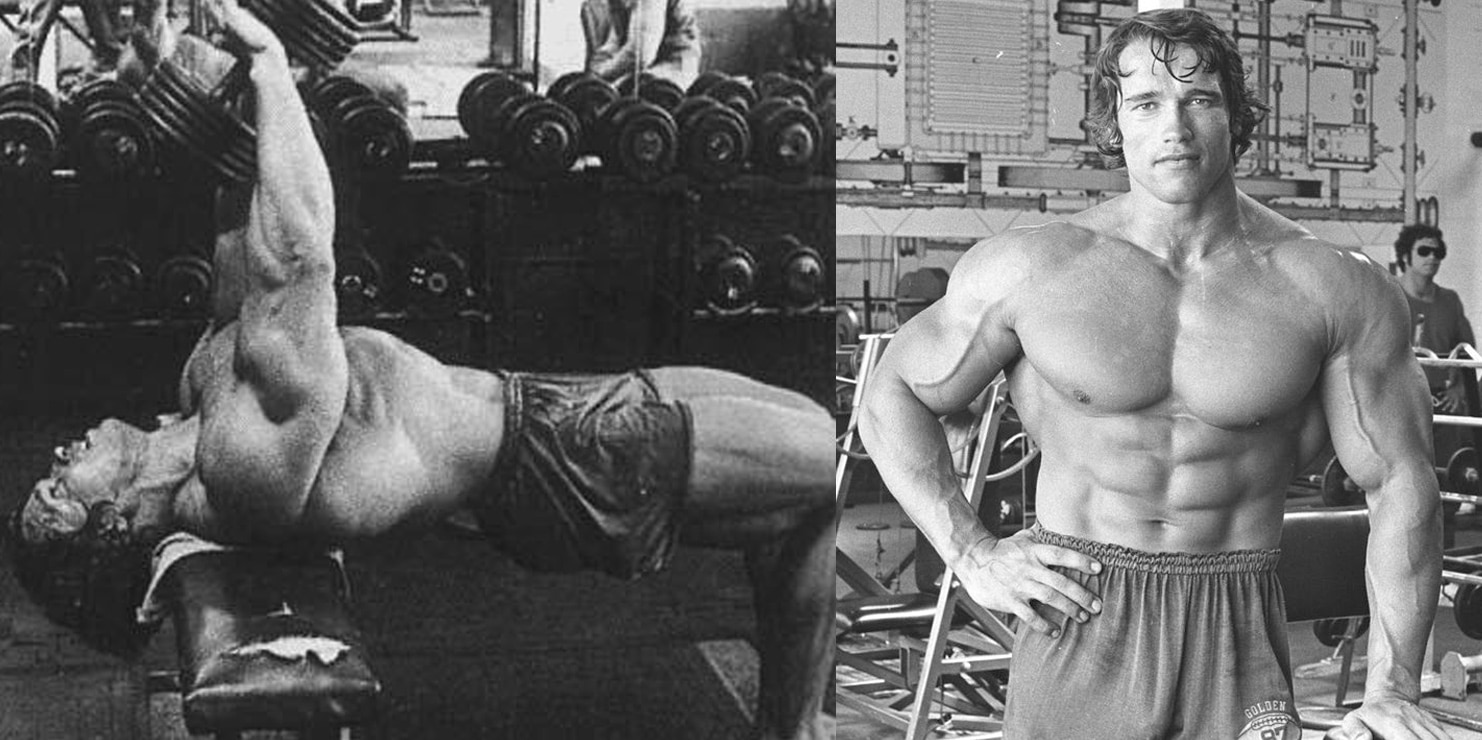
Some people would contend this exercise doesn’t belong on a top-10 list for chest. They’ll either swear up and down that it trains the back, or they’ll belittle it as a relic once revered but now relegated to the training scrap heap because of its potential danger to the shoulders.
The first group is right — it doubles as a fine back exercise. But for those who claim shoulder-impingement concerns, well, we’d instead argue that the problem isn’t the pullover; it’s the lack of flexibility prevalent in today’s gyms. If you don’t have full mobility in your upper back and delts, the pullover simply won’t feel comfortable. You need to work on that, and start doing this staple that served some of the best bodybuilders of all time, from Frank Zane to Arnold Schwarzenegger to Dorian Yates.
Main Areas Targeted: pectorals, latissimus dorsi, serratus
Strengths: Most chest exercises fall into one of two categories: They involve pressing a weight (bending and extending at the elbows) or doing a flye motion (keeping your elbows fixed and closing and opening your arms in front of your body). The pullover is one of a scant few options that work the chest at a completely different angle, in a top-to-bottom contraction.
How-To: Lie on a bench with your upper back, head, and neck supported and your feet flat on the floor. Hold a dumbbell with your arms extended above your face. Maintaining just a slight bend in your elbow throughout, slowly lower the dumbbell backward, allowing your elbows to come to a point at which they align with your ears. When you’ve stretched as far as you can without bending your elbows, flex through your chest and lats to reverse direction to bring the dumbbell back overhead.
The Chest-Building Exercise
1. Incline push-up

Pushups are a great multifunctional exercise because they work the entire upper body and back. Performing pushups at an incline will put more focus on the lower chest.
Equipment:
- a flat workout bench, jump box, or step platform
Steps:
- Stand in front of the bench. Place the hands shoulder-width apart on the edge of the bench.
- Adopt a plank position by extending the legs backward until the legs and back form a straight line. Keep the weight on the balls of the feet.
- Slowly bend the arms to lower the chest toward the bench. Remember to keep the elbows and arms close to the body.
- Slowly push the body away from the bench, extending the arms but maintaining a slight bend in the elbow.
- Perform 8–12 reps for one set.
Push-Up
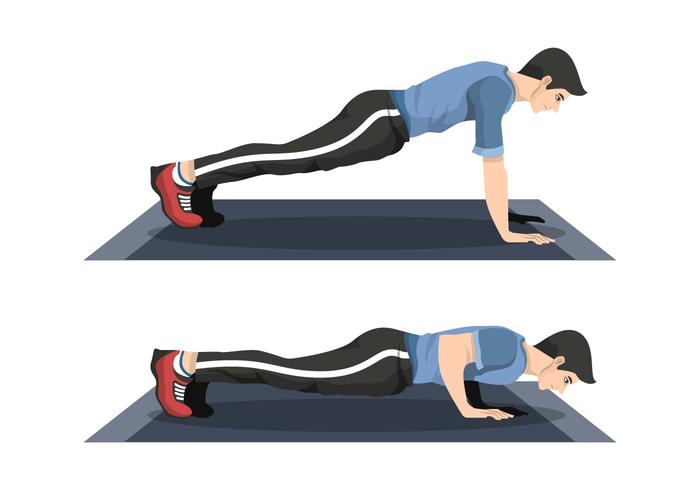
Your drill instructor was a son of a you-know-what, but he was on to something when he screamed, “Drop and give me 20!” The quintessential bodyweight exercise is nearly perfect in its simplicity. “The push-up is a great standard exercise because it requires one piece of equipment — you,” says fitness expert Levi Harrison, M.D., orthopedic surgeon and author of The Art of Fitness: A Journey to Self-Enhancement. “This exercise targets the triceps, pectoralis major, deltoids — especially the anterior portion — and the serratus anterior. When properly done, the push-up also can engage your core muscles effectively.”
Main Area Targeted: pectorals (Note that you can change the emphasis depending on your angle: With feet and hands on the floor, you’ll take aim at the midpecs; elevating your feet on a bench focuses on the upper pecs; and putting your hands on a bench with your feet on the floor hits the lower pecs.)
Strengths: Ever try to pack a set of dumbbells and a bench in a suitcase? (Don’t laugh. Many a gym rat about to go on a trip has contemplated it.) Thing is, most exercise equipment is hard to lug around. Weights are heavy — by design, of course. The answer to staying fit on the road is, in part, using your own body as resistance. Push-ups can be done in hotel rooms, parks, prison cells … anywhere you have solid ground to work with.
How-To: In a plank position, place your feet together, toes on the floor, with your hands wider than shoulder width and flat on the floor and your elbows extended. Keeping your head neutral and abs tight, lower yourself by bending your elbows until your chest gently touches the ground, then press through your palms until your arms are straight once again.
2. Decline dumbbell press
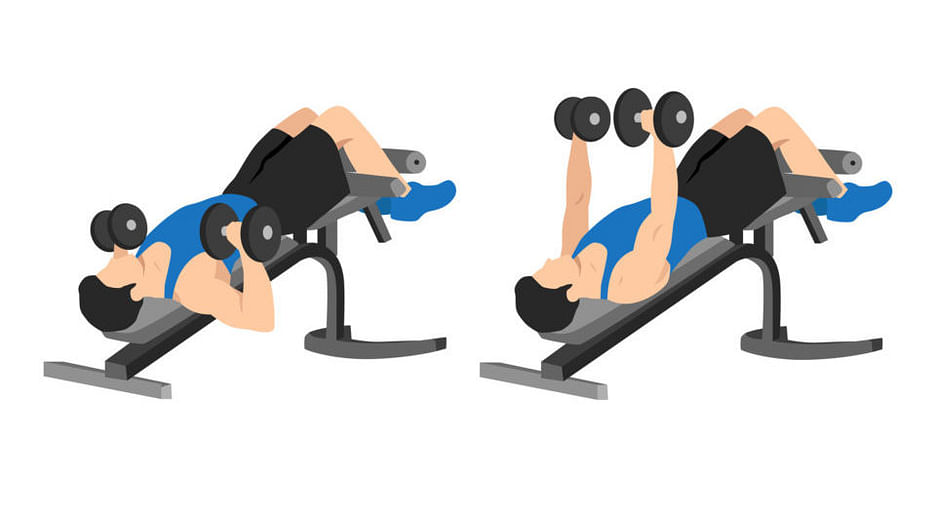
The instructions for this exercise call for dumbbells, but people can use a barbell instead.
Using a barbell will allow people to lift heavier weights for fewer reps, but dumbbells allow a greater range of motion, which may be a better option for people who want to target their lower chest.
Equipment:
- two dumbbells or one barbell
- one decline bench
Steps:
- Set the decline bench at a 45-degree angle, and lie down on it with one dumbbell in each hand. Rest the dumbbells on the thighs with the palms facing inward. Remember to keep the back flat.
- Raise the dumbbells over the chest, extending the arms toward the ceiling. The hands should remain facing inward.
- Hold the dumbbells shoulder-width apart and rotate the wrists until the palms are facing away.
- To begin, bend the arms to form a 90-degree angle at the elbow. The dumbbells should be on the outer edges of the chest.
- Inhale.
- On the exhale, use the chest muscles to push the dumbbells up. Squeeze at the top of the lift and hold for 1–2 seconds.
- Slowly lower the dumbbells to return to the starting position.
- Do 8–12 reps for one set. Rest in between sets.
3 – Dumbbell Floor Press
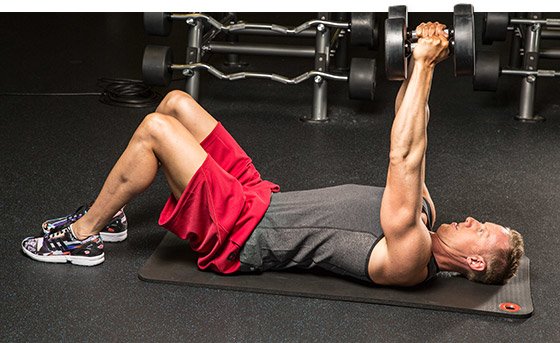
No bench? No problem. Take your dumbbell press to the floor for a shoulder-safe chest pump. This is another excellent option for building up your chest with home workouts since all you’ll need are some weights and some space to spread out.
Do it: Lay back on the floor gripping a pair of dumbbells tightly. Keep your feet flat on the floor, driving with your heels and squeezing your glutes. Keep your elbows at a 45-degree angle relative to your torso to keep your shoulders safe.
Press the dumbbells up and squeeze your chest at the top position. Lower back with control, allowing your elbows to rest briefly on the ground.
4. Cable crossover

Cable machines offer a wide range of exercise options depending on the position of the pulleys. Setting the pulleys higher will put more emphasis on the lower chest while setting them lower emphasizes the upper chest.
The cable crossover works the muscles in both the lower and outer parts of the chest.
Equipment:
- a cable machine
Steps:
- Position the pulleys above the head. Attach one handle to each pulley and then select the desired weight.
- Take one handle in each hand with the palms facing down. Stand in the middle of the cable machine and take a few steps forward to put a little tension on the cables.
- Step one foot forward.
- Lean forward.
- Extend the arms out to the side but keep a slight bend in the elbows. Do not let the elbows move behind the shoulders.
- On the exhale, bring the hands together in front of the body.
- Return to the starting position by slowly extending the arms and inhaling.
- Do 8–12 reps per set, and rest in between sets.
5 – Batwing Fly
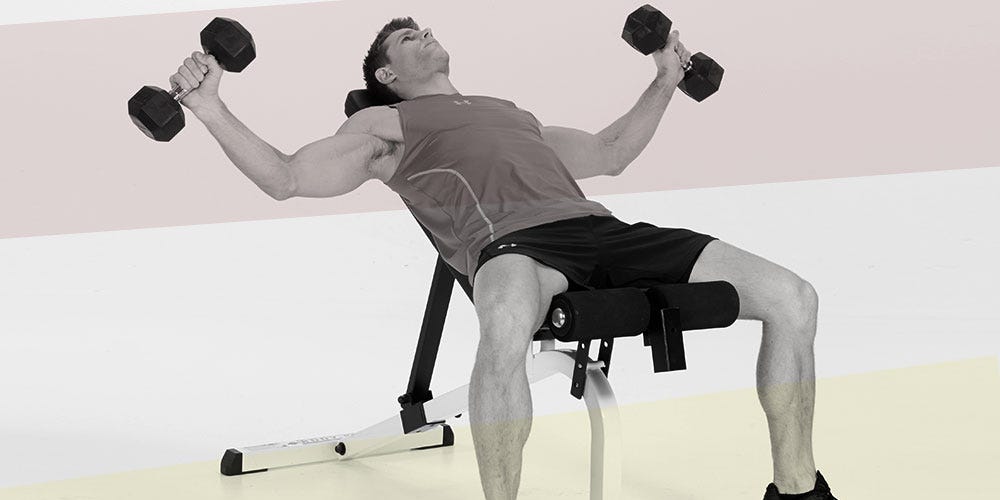
Spend more time at the bottom of the movement to really reap its benefits. Start with light weights to get used to the move, and try alternating between overhand and neutral grips to switch things up.
Do it: Sit on an incline bench with dumbbells in each hand. Start with the weights held with your hands at your pecs, as if you were preparing for a press. Keep your chest strong, with a natural arch in the lower back.
Straighten your arms out to each side, maintaining your strong chest position. Pause for a count with your arms extended, stretching the muscles.
6. Decline dumbbell bench press with external rotation

This move is a variation of the last exercise. It is slightly more complex than a traditional dumbbell press, so people trying this move for the first time might want to use lighter weights until they feel comfortable with the movement.
Equipment:
- two dumbbells or one barbell
- one decline bench
Steps:
- Lie down on the decline bench with one dumbbell in each hand. Rest the dumbbells on the thighs with the palms facing inward.
- Raise the dumbbells over the chest with the arms extended toward the ceiling, keeping the hands in the same position.
- Lower the dumbbells into the starting position, but this time, keep the palms facing inward. Do not rotate the palms. The dumbbells should be parallel to the body.
- Inhale slowly.
- On the exhale, use the muscles in the chest to press the dumbbells up while rotating the palms outward to make the thumbs face each. Squeeze and hold for 1–2 seconds.
- Return to the starting position by slowly lowering the dumbbells while rotating the palms inward.
- Each set should consist of 8–12 reps. Rest in between sets.
7 – Incline Dumbbell Bench Press

This is an upper-body push exercise that targets the pectoralis major (upper chest), clavicular, coastal, and sternal head, along with the anterior deltoids, triceps, biceps, and serratus anterior
“This is a great exercise to implement into your program, giving your upper body push routine some variety,” Shannon says. “The mechanical load and position on the incline bench press provide a greater challenge than the flat or decline bench. This will essentially allow you to get a greater adaptational response with less weight than with the flat bench press. I feel more muscle in the chest and less stress in the shoulder joint when I perform this exercise, in comparison to the flat bench.”
Shannon recommends programming this as either a primary or accessory lift. The prescription all depends on the load, intensity, and volume.
Do it: Lie on a bench with the backrest set at a 45-degree incline. Hold a pair of dumbbells above your chest with your arms straight and your palms turned toward your feet, which should be flat on the floor. Keep your core tight and avoid arching your back, which means your butt should be glued to the seat.
Press the dumbbells up, directly above the shoulders. You might have seen some people in the gym knocking the weights together at the top, but there’s no need to do that here. Lower the dumbbells to chest level—but don’t stress on how deep you go—before you press them back up for the next rep.
8 – Close-Grip Bench Press
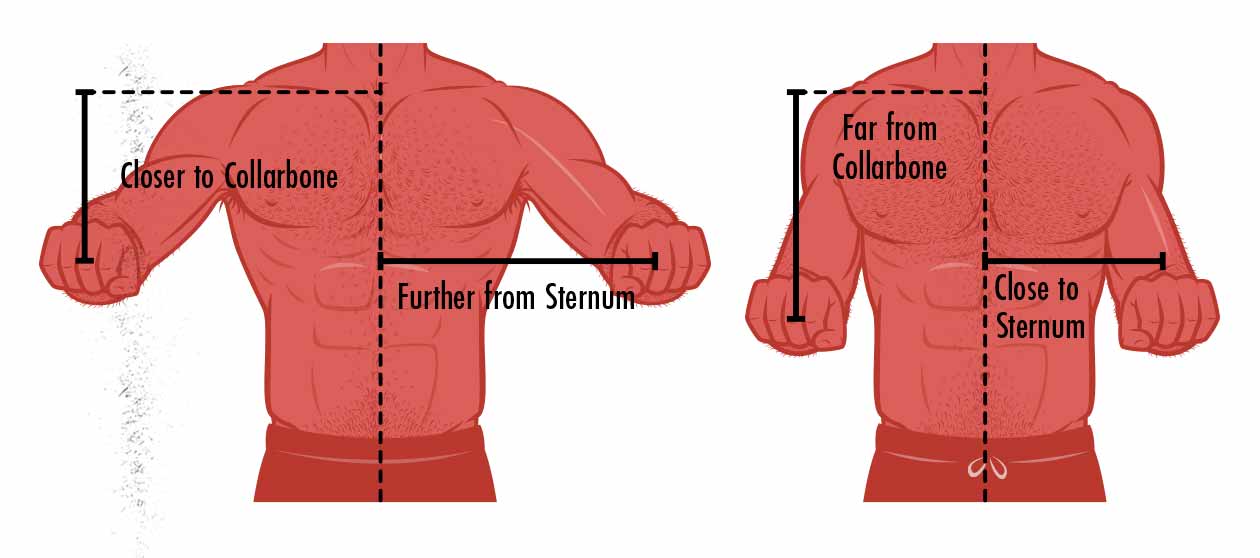
You can lift more weight with a barbell than with dumbbells because they’re more stable. That’s why barbell presses generally build more raw strength in your chest. But this variation puts more focus on your triceps, so you’ll get the bonus of extra work for the biggest muscles in your arms, too.
Do it: Using an overhand grip that’s a bit narrower than shoulder width, hold a barbell above your sternum with your arms straight. Lower the bar to your chest. Hold for 1 second. Press the bar up.
9. Parallel-bar dips (chest)

Parallel-bar dips activate multiple muscle groups in the chest, arms, shoulders, and back. During this exercise, remember to lean slightly forward on the dip to engage the muscles in the lower chest.
Equipment:
- a set of parallel bars
Steps:
- Grip the bars, using the arms to push the body up above them.
- Slowly inhale while bending the arms and leaning the torso forward. Continue lowering the body until there is a slight stretching sensation in the chest.
- On the exhale, lift the body back up above the bars.
- Repeat as many reps as possible without overexerting the muscles.
Parallel-bar dips require a significant amount of upper body strength. People who do not feel comfortable performing a complete chest dip can try the variation below instead.
Parallel-bar dip variation:
- Grip the bars and jump up, so the arms are straight, and the body is above the bars.
- Slowly lower down by bending the arms and leaning forward. Continue until there is a slight stretching sensation in the chest.
- Instead of lifting the body back up, carefully place the feet on the floor and let go of the bars.
- Repeat as many reps as possible without overexerting the muscles. Focus on building strength and expanding the range of motion in the upper body before trying to perform a full chest dip.
10 – Decline Dumbbell Bench Press

Changing the angle on the bench does more than just switch up the scenery. This exercise zeroes in on your lower chest, helping to build serious size, according to Tyler English, C.S.C.S., author of Natural Bodybuilder’s Bible. Do it: Lie on a decline bench with your shins hooked beneath the leg support. Hold a pair of dumbbells above your chest with your arms straight. Your palms should face your feet and the weights should be just outside your shoulders.
Lower the dumbbells to your chest, pause, and then press them back up to the starting position.
11 – Band or Chain Barbell Bench Press
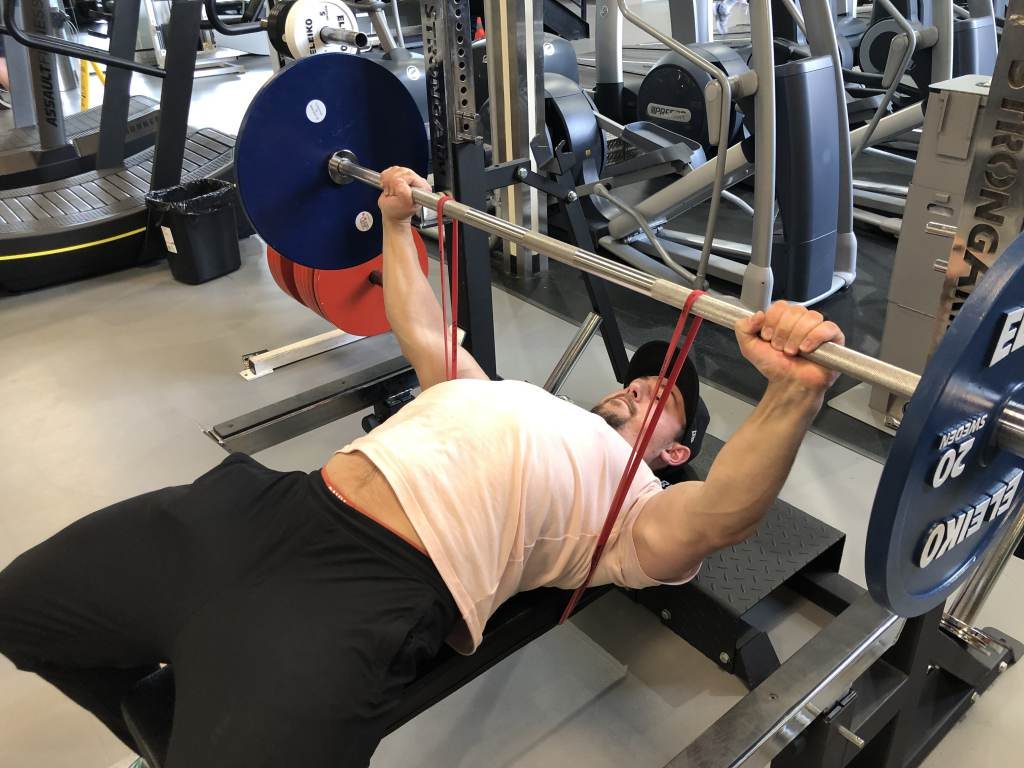
Adding chains or bands to the ends of a barbell changes the load as you move through the different phases of the lift.
Each chain link weighs ‘X’ amount of pounds, and that poundage is now something you’re lifting and managing. As you move through the eccentric (lengthening) part of the lift, lowering the weight to your chest, you’re lessening the load as there is more of the chain on the ground. When you press the weight up, you lift more links of the chain up, bringing that extra weight up. Bands work in a similar manner using the constant tension on the bar.
Do it: Hang a chain over each end of the barbell, or anchor resistance bands to the bench and place them over each end of the bar. Start without weight, in order to get used to the unstable bar.
Grab the barbell and lie on a bench. Using an overhand grip that’s just beyond shoulder width, hold the bar above your sternum, keeping your arms straight. Lower the bar to your chest, and then push it back to the starting position.
12 – Plyometric Pushup
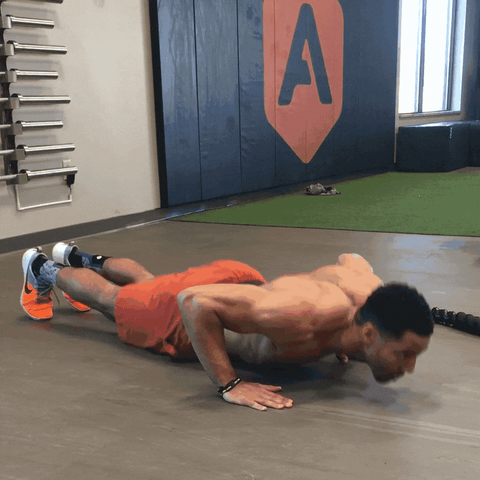
This explosive pushup nails the fast-twitch muscles in your chest, priming them for growth, said English. The movement also gives you another, more powerful option for at-home chest development.Do it: Get into a pushup position, your hands just outside your chest, your feet shoulder-width apart, and your body forming a straight line from head to heels. Brace your core.
Lower your chest to the floor and then press up explosively so your hands come off the floor. If you can pull it off, clap your hands together before returning to the starting position on the ground.
13 – Single-Arm Dumbbell Bench Press

This exercise hits your chest like any awesome bench variation. But what makes it particularly special is that the other side of your body, specifically your core, has to lock down so the dumbbell doesn’t pull you off the bench, says Dan John, legendary strength coach.
The end result: The exercise sculpts your chest—and abs—to a greater degree.
Do it: Lie with your back flat on a bench holding a dumbbell in your right hand. Press the dumbbell directly over your chest until your arm is straight. Slowly lower the dumbbell to the right side of your chest.
Pause, then press it back up. Do all your reps on your right side, and then repeat on your left.
14 – Suspended Pushup
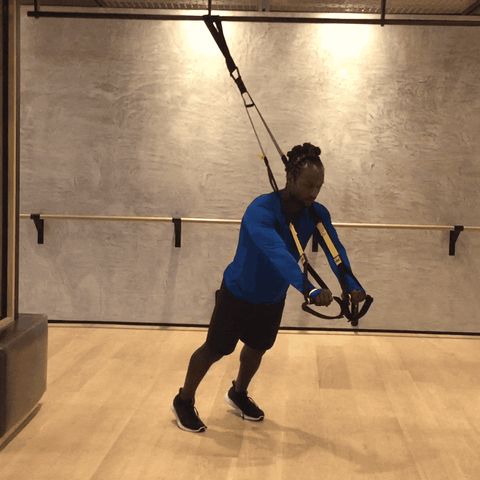
Performing pushups with your hands in an unstable suspension trainer works your core, chest, and stabilizer muscles harder than doing pushups on the floor, said English. Using the TRX straps makes this another more accessible option for home training.
Do it: Grab the handles of a TRX strap and extend your arms in front of your chest. Your feet should be shoulder-width apart and your body anywhere from 45 degrees to parallel from the floor. Your body should form a straight line from head to heels.
Lower your chest toward the floor until your hands are just outside your shoulders. Keep your elbows in and your head in a neutral position as you lower. Brace your core throughout the movement.
